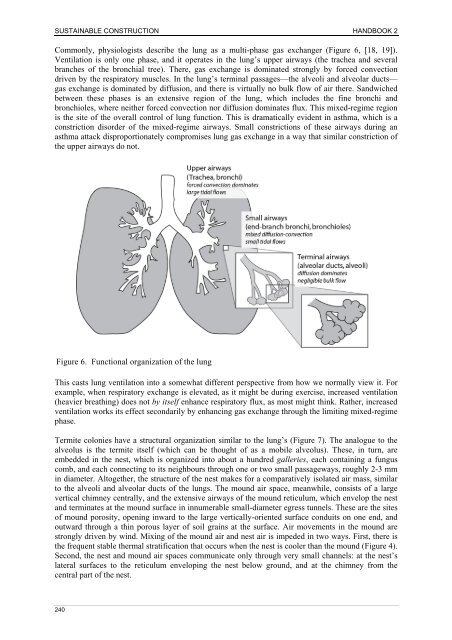Industrialised, Integrated, Intelligent sustainable Construction - I3con
Industrialised, Integrated, Intelligent sustainable Construction - I3con
Industrialised, Integrated, Intelligent sustainable Construction - I3con
You also want an ePaper? Increase the reach of your titles
YUMPU automatically turns print PDFs into web optimized ePapers that Google loves.
SUSTAINABLE CONSTRUCTION HANDBOOK 2<br />
Commonly, physiologists describe the lung as a multi-phase gas exchanger (Figure 6, [18, 19]).<br />
Ventilation is only one phase, and it operates in the lung’s upper airways (the trachea and several<br />
branches of the bronchial tree). There, gas exchange is dominated strongly by forced convection<br />
driven by the respiratory muscles. In the lung’s terminal passages—the alveoli and alveolar ducts—<br />
gas exchange is dominated by diffusion, and there is virtually no bulk flow of air there. Sandwiched<br />
between these phases is an extensive region of the lung, which includes the fine bronchi and<br />
bronchioles, where neither forced convection nor diffusion dominates flux. This mixed-regime region<br />
is the site of the overall control of lung function. This is dramatically evident in asthma, which is a<br />
constriction disorder of the mixed-regime airways. Small constrictions of these airways during an<br />
asthma attack disproportionately compromises lung gas exchange in a way that similar constriction of<br />
the upper airways do not.<br />
Figure 6. Functional organization of the lung<br />
This casts lung ventilation into a somewhat different perspective from how we normally view it. For<br />
example, when respiratory exchange is elevated, as it might be during exercise, increased ventilation<br />
(heavier breathing) does not by itself enhance respiratory flux, as most might think. Rather, increased<br />
ventilation works its effect secondarily by enhancing gas exchange through the limiting mixed-regime<br />
phase.<br />
Termite colonies have a structural organization similar to the lung’s (Figure 7). The analogue to the<br />
alveolus is the termite itself (which can be thought of as a mobile alveolus). These, in turn, are<br />
embedded in the nest, which is organized into about a hundred galleries, each containing a fungus<br />
comb, and each connecting to its neighbours through one or two small passageways, roughly 2-3 mm<br />
in diameter. Altogether, the structure of the nest makes for a comparatively isolated air mass, similar<br />
to the alveoli and alveolar ducts of the lungs. The mound air space, meanwhile, consists of a large<br />
vertical chimney centrally, and the extensive airways of the mound reticulum, which envelop the nest<br />
and terminates at the mound surface in innumerable small-diameter egress tunnels. These are the sites<br />
of mound porosity, opening inward to the large vertically-oriented surface conduits on one end, and<br />
outward through a thin porous layer of soil grains at the surface. Air movements in the mound are<br />
strongly driven by wind. Mixing of the mound air and nest air is impeded in two ways. First, there is<br />
the frequent stable thermal stratification that occurs when the nest is cooler than the mound (Figure 4).<br />
Second, the nest and mound air spaces communicate only through very small channels: at the nest’s<br />
lateral surfaces to the reticulum enveloping the nest below ground, and at the chimney from the<br />
central part of the nest.<br />
240






